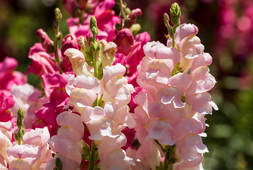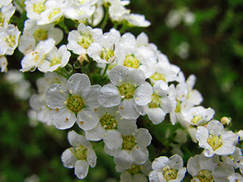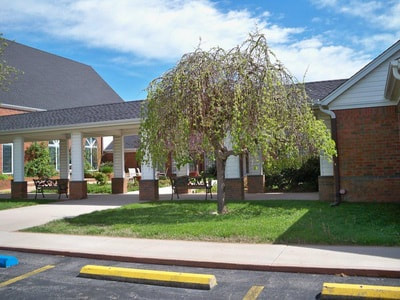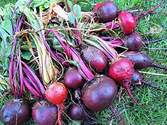|
Ozark Green Thumb BCMG Monthly e-Newsletter |
|
|
|
In this month’s article I want to mention things gardeners need to be considering for May. The following is a garden checklist:
1 Comment
 Snapdragons have come into their own for summertime bloom thanks to the efforts of modern day plant breeders.Summertime blooms are important in any flower garden, but heat and humidity often cause flowers to falter and then fail. Not so with Angelonia, or summer snapdragon. It thrives in summertime heat and humidity because it belongs to a group of tropical species found from Brazil to Mexico. Angelonia has gone from obscurity a decade ago to one of the favorites for summertime gardeners. Angelonia angustifolia is a member of the snapdragon family native to Mexico, Cuba and parts of the West Indies. It’s an herbaceous annual in temperate gardens, but in warm places it persists as a perennial. In tropical regions, it can become a sub-shrub. It grows to about 2 feet tall and 18 inches wide in a sprawling mound. Though it has a sprawling habit, its branches are strong, and it never needs staking. The 3-inch long leaves are bright green, simple and willow like. Flowers appear singly in terminal leafy spikes during the summer. Individual flowers are in shades of pink, blue or white and are about an inch across. The throat is open, with the five petals reflexed backwards just a bit. The wild species is more two-lipped as found in most members of the scroph family, but plant breeders have selected forms with more open flowers. Angelonia shows no photoperiod response, but is temperature sensitive. It only blooms well when average temperatures are above 75 degrees Fahrenheit. Angelonia is one of the “new” flowers that appeared, really reappeared, on the horticultural scene during the mid 1990s. It was first grown in the late 19th century but never made its way out of greenhouse conservatories. With the new plant revival, it began to be offered as a patio plant and breeders began developing better garden forms. Modern hybrids involve A. angustifolia and A. integerrima and old cultivars such as Pacific Blue and Alba, a 100-year-old white clone. The Ball people introduced the AngelMist series in 1998; the AngelFace series from Proven Winner appeared in about 2005. The new hybrids are more robust growers than the wild species and display the flowers in a more open fashion. Though seeds are occasionally offered, most plants are grown from cuttings. Angelonias should be planted in sunny locations in a well-drained soil amended with organic matter. It’s not a heavy feeder but benefits from occasional fertilization, especially if blooming has been heavy. Though most commonly seen in southern gardens, Angelonia has done well throughout the country. It’s reliably winter hardy only in zone 10. It makes a good cut flower and will last for more than a week in a vase. Cutting encourages more blooms later in the season. Some gardeners recommend shearing plants back in midsummer to encourage a late season flush of blooms. It’s well suited for use in the mixed border or for patio planters. Once established, Angelonia has great drought tolerance, but we’re talking lantana kind of drought tolerance, not cactus drought tolerance. By: Gerald Klingaman, retired
Extension Horticulturist - Ornamentals Extension News - August 15, 2008  Even before its foliage appears, bridal veil spirea, much more commonly known as bridal wreath spirea (Spiraea prunifolia) graces the early spring landscape with a profusion of white blossoms. This species can grow to 9 feet tall, with arching branches that may bend to the ground, contrasting with another group of spireas that are low-growing and shrubby and bear pink or red flowers in the summer. Bridal wreath flourishes in U.S. Department of Agriculture plant hardiness zones 5 through 8. Maintain the plant's flowing shape by cutting it back immediately after blooming stops. The spring-blooming bridal wreath spirea produces buds on old wood. Therefore, avoid pruning at the end of winter, or you might destroy potential flowering branches. You can, however, remove winter-killed twigs. "Plena," the most commercially-available bridal wreath variety, requires some winter chill to flower generously, and as with the species grows best in USDA zones 5 through 8. Propagate cuttings from your spirea in early spring by snipping 4 to 8 inches off a fast-growing stem tip and rooting it in a sandy potting mix. Never try to prune a bridal wreath spirea into a compact bush, or you will sacrifice its unique charm. Trimming back so that it does not get too unwieldy, however, makes the plant more attractive. After flowering, prune any awkward shoots that distract from the overall configuration. With time, bridal wreath tends to become sparse and leggy. To rejuvenate a spirea, you can cut it almost to the ground, and it will grow back in a healthier state. Remember to clean your pruning shears with household disinfectant at full strength to avoid spreading bacteria, viruses or fungi. The double, white flowers of the "Plena" bridal wreath spirea each measure about 1/3 inch across and emerge in clusters of three to six blossoms. Spireas belong to the rose family, and their blooms resemble tiny roses. A favorite of butterflies, the snowy flowers lining the bare branches can be breathtaking, especially when the sun shines on them. The dark-green foliage that comes in following flowering will later furnish autumn color in reds, oranges or yellows. Besides the yearly pruning, bridal wreath spirea does not require extensive maintenance to thrive. The plant does well in almost any soil, but it prefers the soil be a bit moist. For optimal blooming, grow spirea in full sun, although it tolerates partial shade. Usually the plant escapes serious damage from disease or insect pests, but watch for some of the same problems that afflict roses, such as fire blight, leaf spot, powdery mildew, aphids, root rot, leaf roller and scale. Use bridal wreath spirea as a foundation planting, in an informal mixed hedge or as a specimen shrub. Source: Clemson Cooperative Extension
 The Baxter County Master Gardeners are a fun group of folks who enjoy sharing their love of gardening with any visitor. At our meetings we have speakers, refreshments, & fun. Come join us! Next Meeting Date: June 14th from 1:00 - 3:00 pm Meeting Place: The First Presbyterian Church 1106 Spring Street Mountain Home, AR June Speakers: Audrey Holt and Jeffree Pearson, The Art of Flower Arranging Audrey Holt is attracted to art in many forms; whether it is finding beauty in creating a painting, capturing the best view in a photo, planning a garden or designing a flower arrangement. Audrey is a Life Member of the Master Gardeners. Over the years she has created floral arrangements for personal enjoyment and for various gatherings; earned Blue Ribbons and Best of Show for fair entries; conducted a SIG for Master Gardeners on Flower Arranging; presented a power point on Flower Arranging for state meeting of 4H leaders. At Judging Schools Audrey gave demonstrations on judging flower arrangements, and has been Horticulture Judge at county and district fairs which included judging flower arrangements. Jeffree Pearson is a new Master Gardener from the fall 2017 class. He enjoys making flower arrangements and agreed to assist with the program on the Art of Flower Arranging. Jeffree says that most of what he knows, he picked up on his own before he worked for about five years for a florist. With practice and experimentation there is much to learn, enjoy and share on creating attractive floral arrangements. Master Gardeners Monthly Radio Program: Mountain Talk Radio June 20th on 97.1 7:15 a.m. - 8:am. Master Gardener Hosts this month are Tommy Hagan and Ceil Gasiecki Directions: From Mountain Home Take US Hwy. 62B East through Mountain Home until you come to Cardinal Street. Cardinal Street is the intersection just past Harp's Grocery. Turn right onto Cardinal Street and travel South until you come to the first stop sign which should be Spring Street. Turn left onto Spring Street and go down the hill past the bridge and the First Presbyterian Church will be on your right hand side. From Gassville: Take Hwy. 62/412 towards Mountain Home. Once you get to Mountain Home continue on into Mountain Home on US 62B. This will take you through town till you get to Harp's Grocery and you come to Cardinal Street. Cardinal Street is the intersection just past Harp's Grocery. Turn right onto Cardinal Street and travel South until you come to the first stop sign which should be Spring Street. Turn left onto Spring Street and go down the hill past the bridge and the First Presbyterian Church will be on your right hand side.  I grew up eating beets, but only the pickled kind from the Mason jars my mother canned in considerable quantity. Nowadays I can’t pass them by at a salad bar where they seem to have taken up permanent residence. Since my youth I’ve encountered stewed beets -- OK but not great-- and on a trip to Russia, borscht, which quickly became a favorite. Beets (Beta vulgaris), though a humble root vegetable, have an interesting history. Beets have been domesticated about 4,000 years, probably first brought into cultivation as a leafy green around the Mediterranean basin. The plant has long been classified as belonging to the chenopod family, the same family to which spinach belongs, but new classification schemes using DNA data have moved this whole family into the amaranth family. Chard, a leafy selection of the beet, seems to have been displaced as a common greens crop by spinach when it became more widely grown. Beet plants are biennial herbs that are usually grown as annuals. They form a large inflated tap root and leafy rosette of leaves that bolt in the early summer of the second season and produce a tall growing stem containing insignificant clusters of small flowers on 6-foot tall stems. From the gardener’s perspective, if the plant ever bolts and produces flowers, the optimum time for harvest has been missed. Taxonomically four principle subsets of this species are recognized; 1) chard which is grown for its edible leaves and does not produce a tap root, 2) mangel-wurzel, a beet root developed as a wintertime fodder for cattle 3) sugar beets for sucrose production and 4) table beets which, while primarily seen in bright red, are also available in golden yellow and white forms. The red/purple pigment associated with beetroot is from various betalains, water soluble pigments formed from an indole based pathway that are found in plants in the Caryophyllales order. This category of plant classification is an umbrella group housing many seemingly unrelated plant families such as cacti and beets. However, because beets, cacti and amaranth all have betalin pigments, logic dictates they must descent from some common ancestor that produced this kind of color pigment instead of the more common, but completely chemically unrelated anthocyanin pigment, found in other plants with red flowers or leaves. The red/purple pigment associated with beetroot is from various betalains, water soluble pigments formed from an indole based pathway that are found in plants in the Caryophyllales order. This category of plant classification is an umbrella group housing many seemingly unrelated plant families such as cacti and beets. However, because beets, cacti and amaranth all have betalin pigments, logic dictates they must descent from some common ancestor that produced this kind of color pigment instead of the more common, but completely chemically unrelated anthocyanin pigment, found in other plants with red flowers or leaves. Red table beets were taken to northern Europe during the years of Roman occupation where, until the 17th century they were known as “Roman beets.” Both the beetroot and the tops are edible with the leaves either cooked similar to spinach or eaten fresh as salad greens. They arrived in America with the earliest settlers but never gained much prominence as a crop until the middle years of the 18th century when a German scientist discovered that the sugar found in beets and sugar cane, sucrose, was the same. Ordinary table beets contain 2 to 6 percent sucrose but selection efforts quickly elevated the sugar beet sugar content to about 10 percent. The French, during the English-imposed blockade which stopped cane sugar shipments during the Napoleonic Wars, were the first to take advantage of this newly developed technology and opened the first sugar beet extraction plant in 1802. Sugar beets were imported to the United States in the 1830’s with the first extraction plant opening in California in 1879. Over the next century and a half the world supply of sugar has equaled out with half coming from cane and half from beets. Beets are easy to grow in the vegetable garden. Plant the seeds about 1.5 inches apart in a row about a month before the last frost date. Beet seed is actually a cluster of seeds bound together in a naturally occurring seed ball, so after emergence, seedlings should be thinned to 1.5 inches apart. Multiple plantings at four-week intervals will ensure continual production through the year. Beetroots continue to enlarge as long as they remain in the ground, but roots of a usable size can usually be produced in 60 to 70 days. By: Gerald Klingaman, retired
Retired Extension Horticulturist - Ornamentals Extension News - May 31, 2013  Prep: 20 minutes Cook: 20 minutes Serves: 12
In a large saucepan cook shallots and garlicin hot oil over medium heat untill tender.
Carefully stir quonoa or barley. Cook and stir about 5 minutes or until quonoa or barley is golden brown. Carefully stir in broth, thyme and bay leaf. Bring to boiling; reduce heat. Cover and simmer about 20 minutes or until quinoa is tender and fluffy (cook barley about 10 minutes or until tender and liquid is absorbed. Discard bay leaf. Gently stir in roasted peppers. Season to taste with kosher salt and black pepper. Nutrition facts per serving: 125 calories, 3 grams total fat(o sat. fat), 0 mg chol, 169mg sodium, 21 grams carbs, 2g fiber, 4 gm protein.  This an easy desert that can be prepared ahead of time. Makes six servings.
Preheat oven to 350. Line a 9 inch cake pan
with parchment paper. Beat egg whites untill stiff peaks form. Stir 4 tablespoons of the honey and all the ricotta together in a bowl. Fold in egg whites. Spread mixture in a cake pan and bake for 40 minutes or till risen and golden. Meanwhile, gently heat the berries untill softened. Stir in remaining honey and simmer for 10 t0 20 minutes. Serve blueberry sauce over ricotta pie wedges. |
Archives
April 2022
|
|
